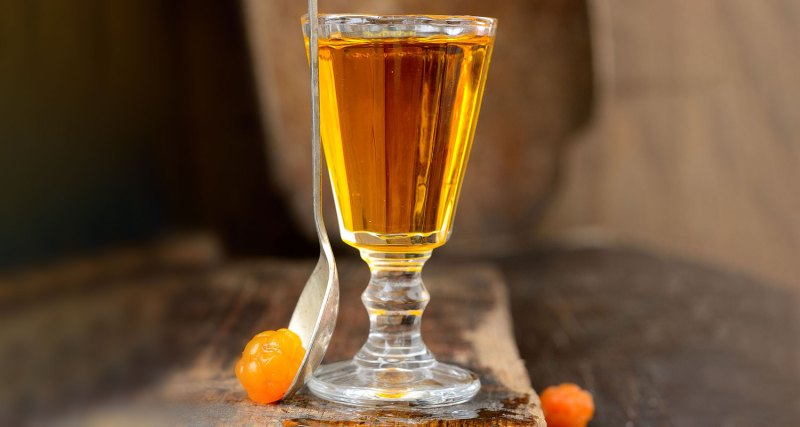
Get Your Head Out of the Cloudberries
Cloudberries are wild berries found in the wetlands and tundras of the Northern Hemisphere, particularly in the Arctic region. Praised highly in Nordic countries (they’re featured on certain coins in Finland), cloudberries have a more low-key reputation in Alaska, Canada, Greenland, and Japan.
The sun-kissed (well, more like sun-flirted) orange fruit looks a bit like a blackberry and a raspberry merged and were then shrunken down. If the color didn’t give it away, cloudberries are loaded with vitamin C. They also have a bittersweet taste with a mouthfeel that grows creamier as the berry ripens. Internationally, these berries find their way into jams and desserts, but we’re really into how Finland creates the golden liqueur known as Lakka.
How Is Lakka Made?
The scarcity of Lakka lies in its cultivation. No one’s really farming cloudberries; they’re essentially a delicious weed. At various stages of ripeness, the berries are hand-picked for different uses. By steeping cloudberries in neutral grain alcohol for two to six months, Lakka takes a sweeter, almost floral approach compared to the herbal aquavits of the region. After soaking in oak barrels for months, natural sweeteners, like honey, and spices, like cinnamon or clove, are added to the alcohol.

With different harvest and soak times, the handful of Lakka distributors out there yield slightly different results. The popular Lapponia Lakka will give you some subtle berry notes, but Hermannin’s Kukki is more cloudberry-forward. Chymos is the sweetest and creamiest of the three, making its cocktail applications a little different. All three hit an alcohol volume of 21 percent, but Lakkas can have an A.B.V. as low as a 15 percent.
Lignell & Piispanen (two dudes, one company) fall more in the craft liqueur category and are committed to making traditional berry-based alcohol. The lingonberry liqueur flies off local shelves, but the brand is also known for maintaining the pre-prohibition recipe for Lakka. The conservative temperance movement that plagued Scandinavian alcohol consumption found its way to Finland multiple times between 1775 and 1932. Founded in 1852, Lignell & Piispanen has the oldest, mass-marketed Lakka recipe in the country. If you can get your hands on a bottle, you can taste a little history.
How do you enjoy Lakka?
Typically, you only need a (cordial) glass to enjoy Lakka, chilled or not. Lignell & Piispanen also makes a cloudberry dessert wine for those of you who have your dentist on speed dial. This rare treat is often saved for special occasions and holidays in Finland, but a few mixed drinks have made their way into local bars.
The sweet-tart flavor makes Kukki an interesting substitution for orange simple syrup, but the creamier the Lakka is, the more tropical your drink options become. The creamy Chymos is most commonly used in coffee cocktails, like a Finnish amaretto. Lapponia hits the sweet spot between a citrus-like kick and initially unsettling yogurt vibes. If you’d like to try your hand at a Lakka cocktail, here are a few recipes in order of increasing difficulty.
Supersonic Gin and Tonic
(Created by Joseph Piercy, Slippery Tipples: A Guide to Weird and Wonderful Spirits & Liqueurs )
- 1 oz Lakka
- 1 oz Plymouth Gin
- 2 oz tonic
- 1 lemon slice
Method: Build ingredients over ice and stir. Float lemon slice to garnish.
Lakka Cafe
(Courtesy of Complete Cocktails)
- 1 ½ oz Chymos Lakka
- 3 oz chilled coffee
- 1 oz light cream
- Coffee beans
Method: Shake ingredients vigorously with ice in a cocktail shaker. Strain into a chilled wine glass. Garnish with a few coffee beans.
Call of the Snowfields
(Courtesy of Drink Swap)
- ¾ oz Lapponia Lakka Cloudberry Liqueur
- ¾ oz Parfait Amour
- ¾ oz cream
- ¾ oz pineapple juice
- Grated nutmeg
Method: Blend ingredients with ice and pour into cocktail glass. Sprinkle grated nutmeg on top.
Carrot Cocktail
(Created by Jesse Auvinen, Latva Bar, Helsinki, Finland)
- ¾ oz Marskin Ryyppy (Mannerheim’s Schnapps)
- ¾ oz Gustav Cloudberry Liqueur (Lignell & Piispanen)
- 1 ½ oz freshly-squeezed carrot juice
- ⅓ oz carrot syrup*
- ⅓ oz lemon juice
Method: Measure the ingredients into a shaker and shake vigorously. Pour into cocktail glasses and garnish with slivers of carrot.
*Carrot syrup: Peel and chop ½ cup of carrots. Cover carrots with water and boil them until tender. Strain carrots and mash them, keeping the water. Mix water, carrots, and 4 tbsp of honey in a bowl. Store in a cool place.



